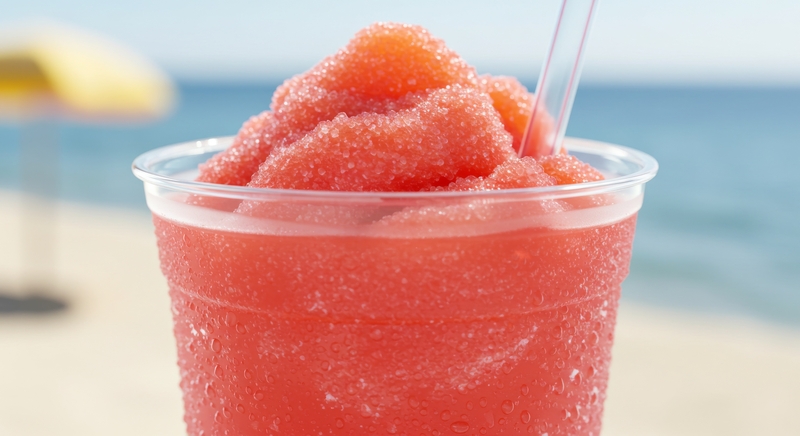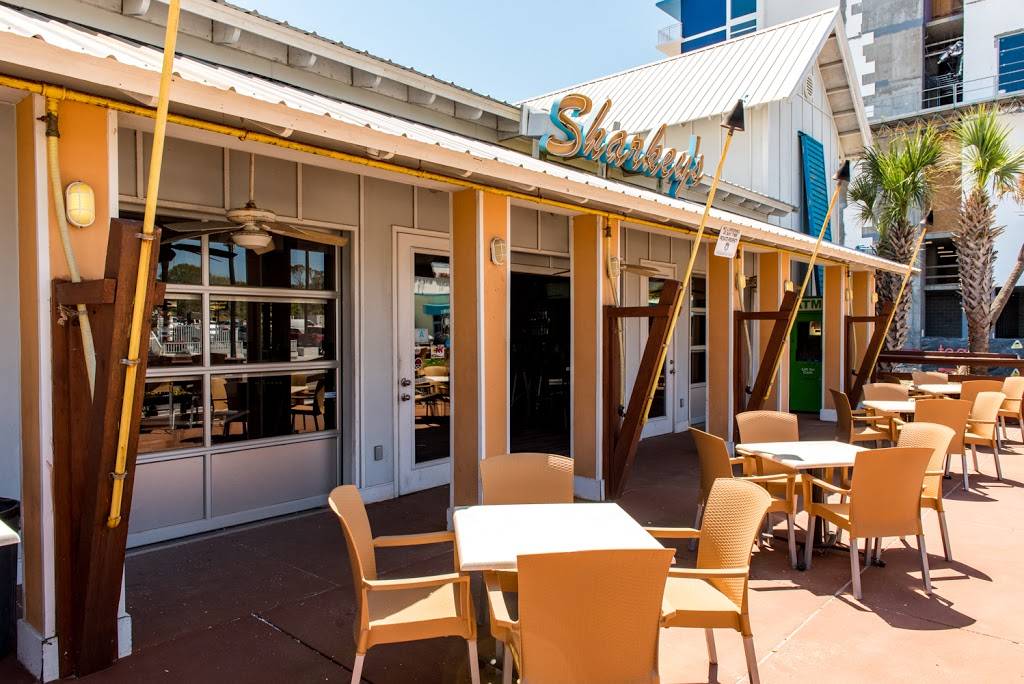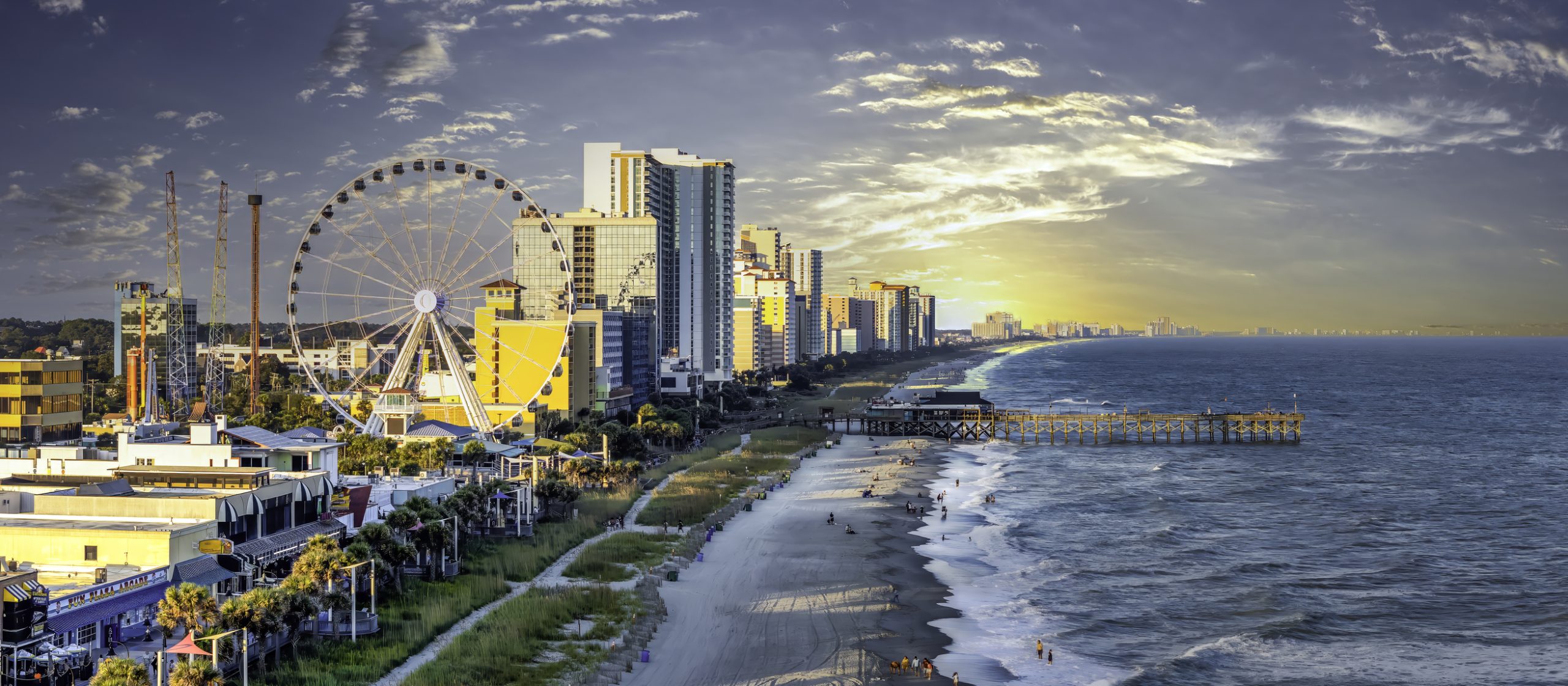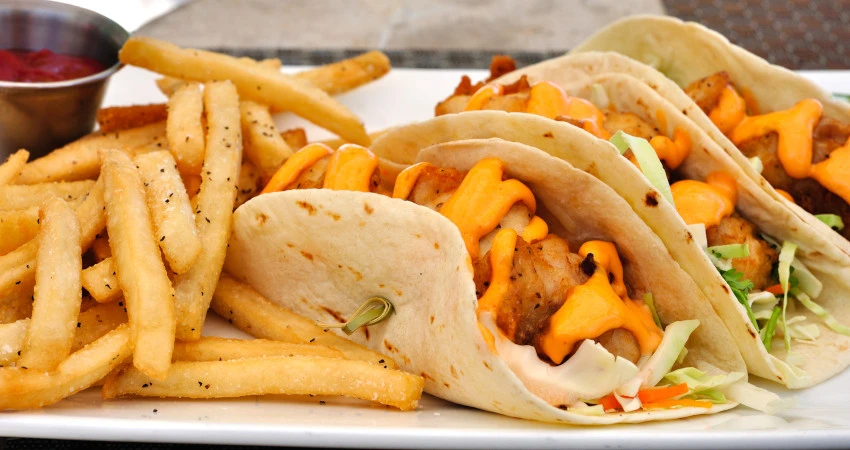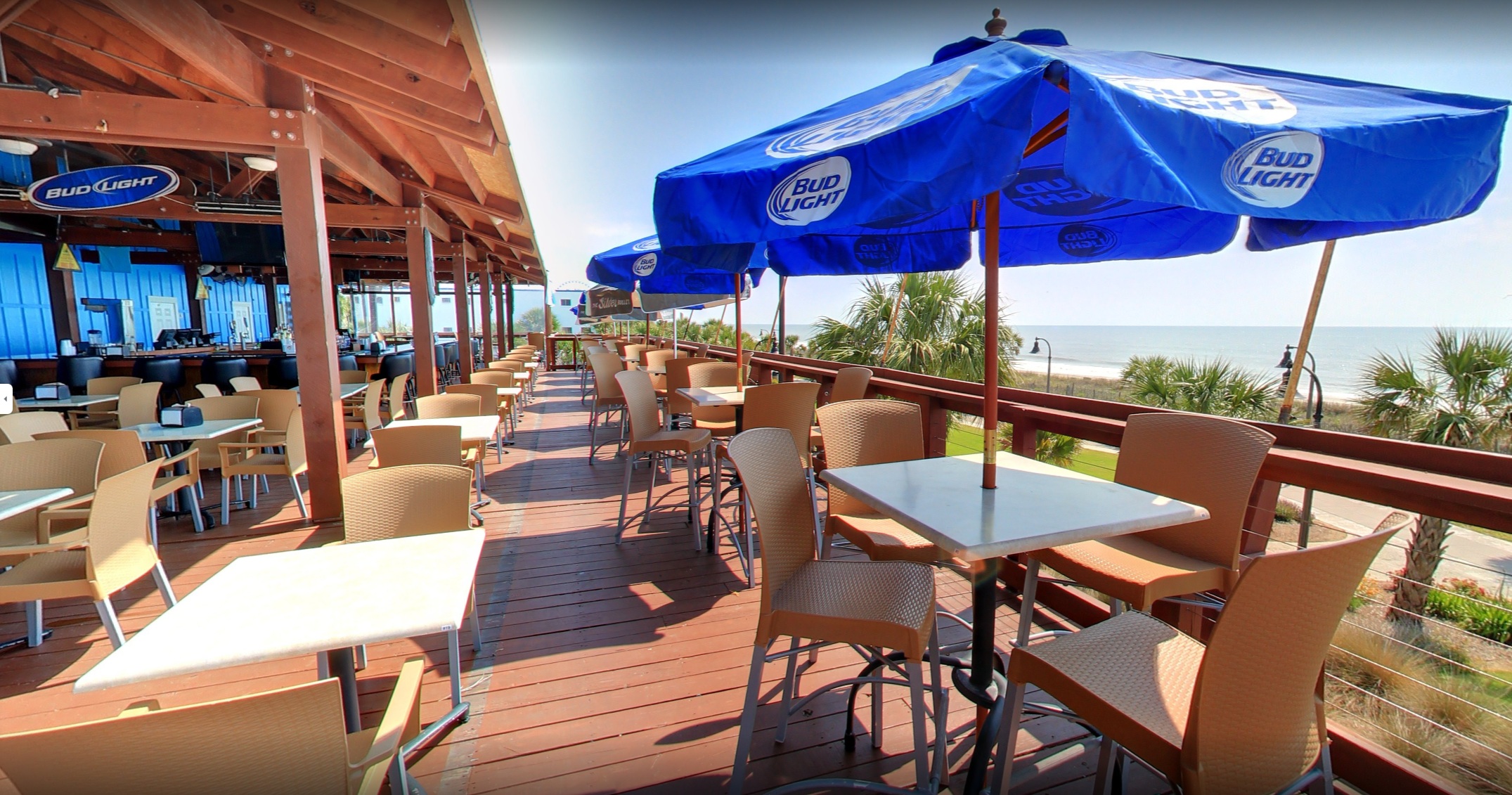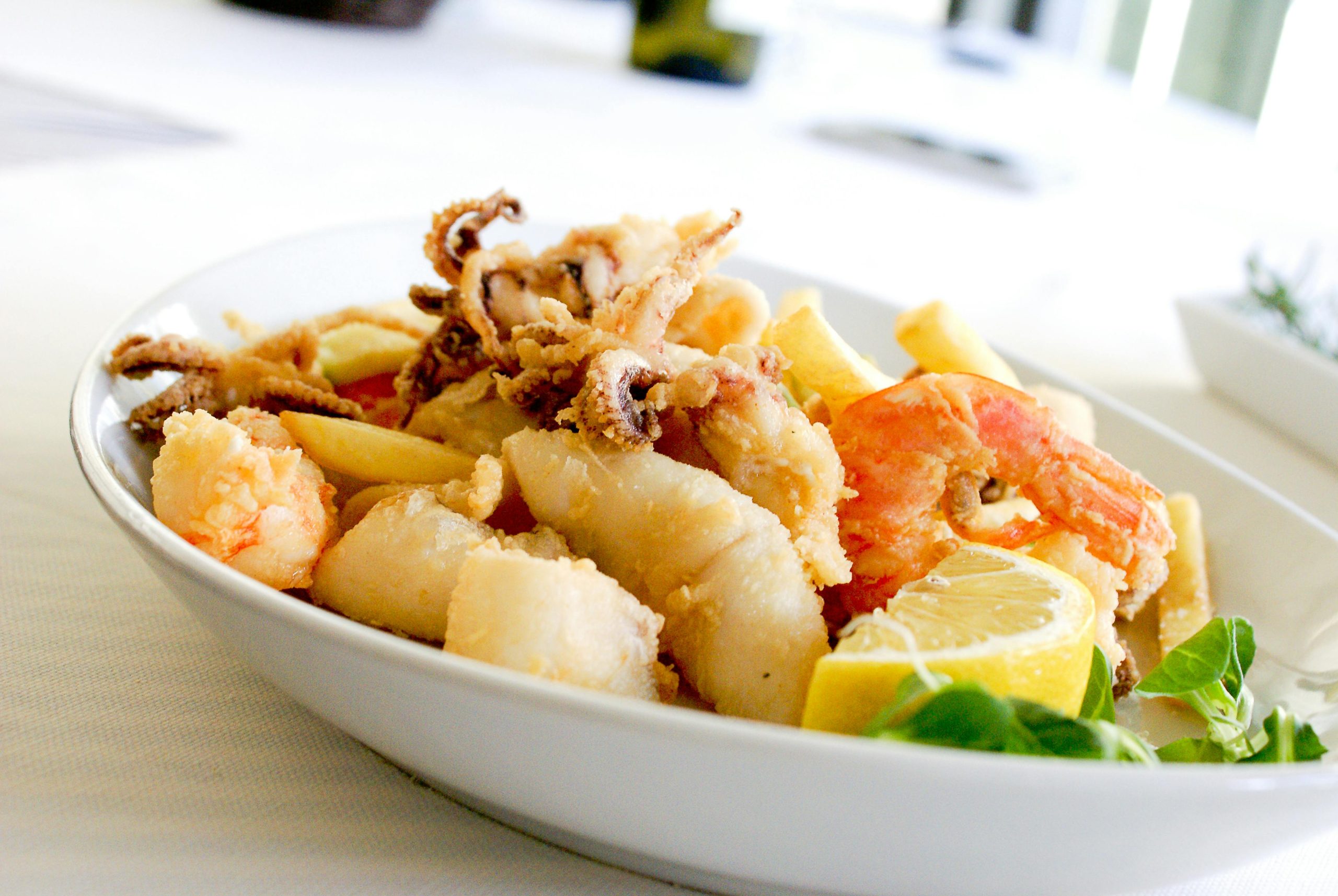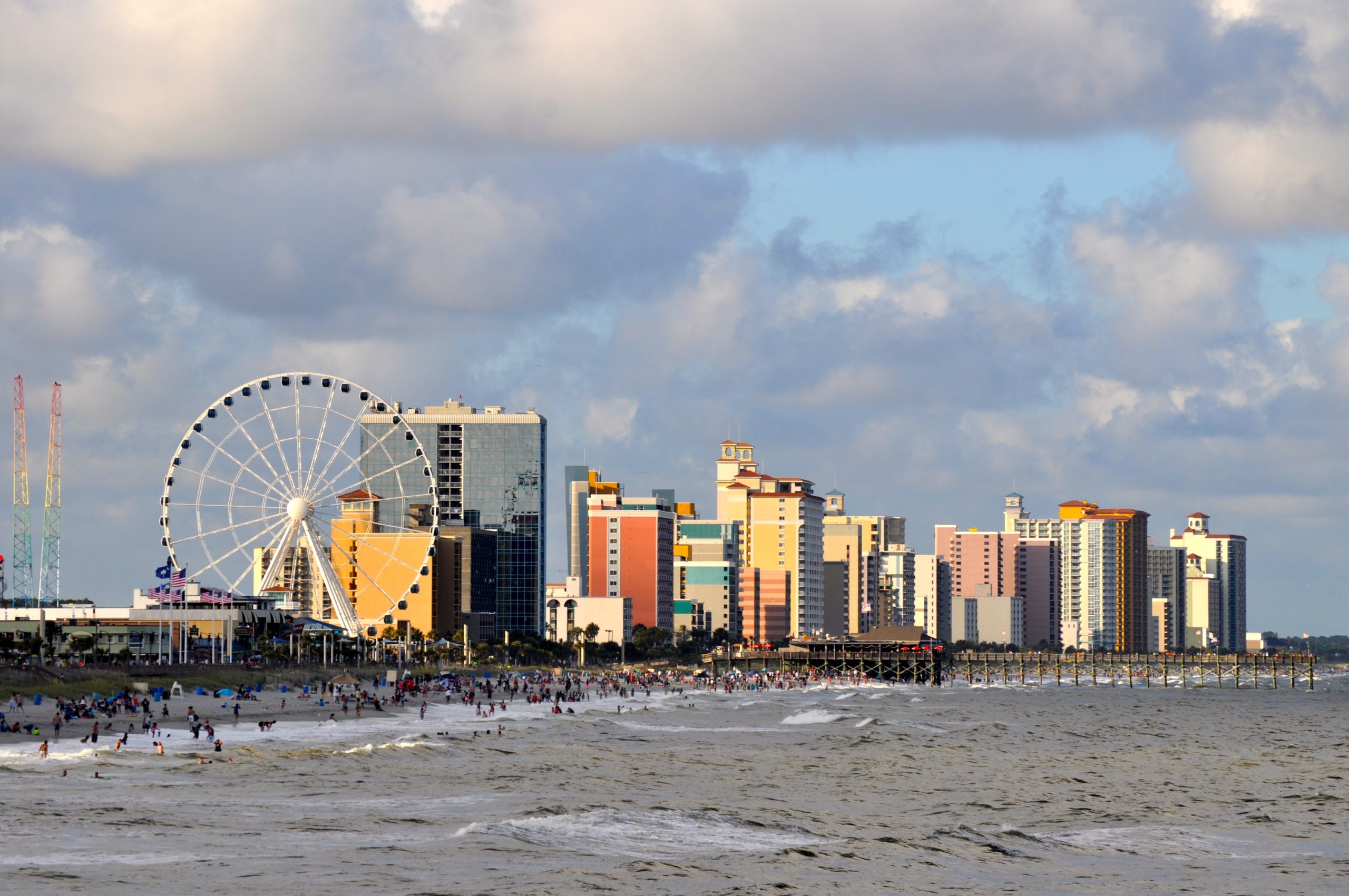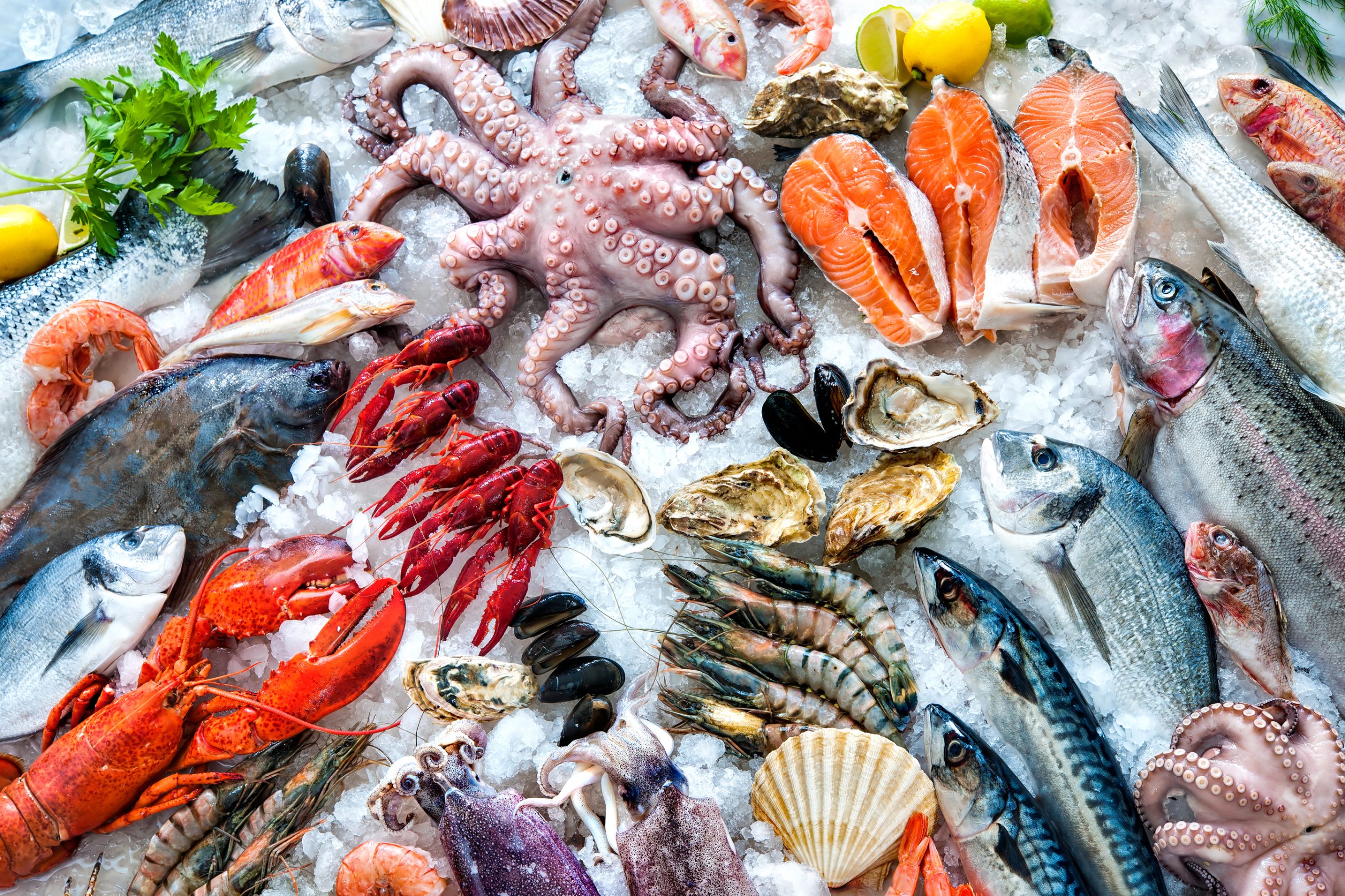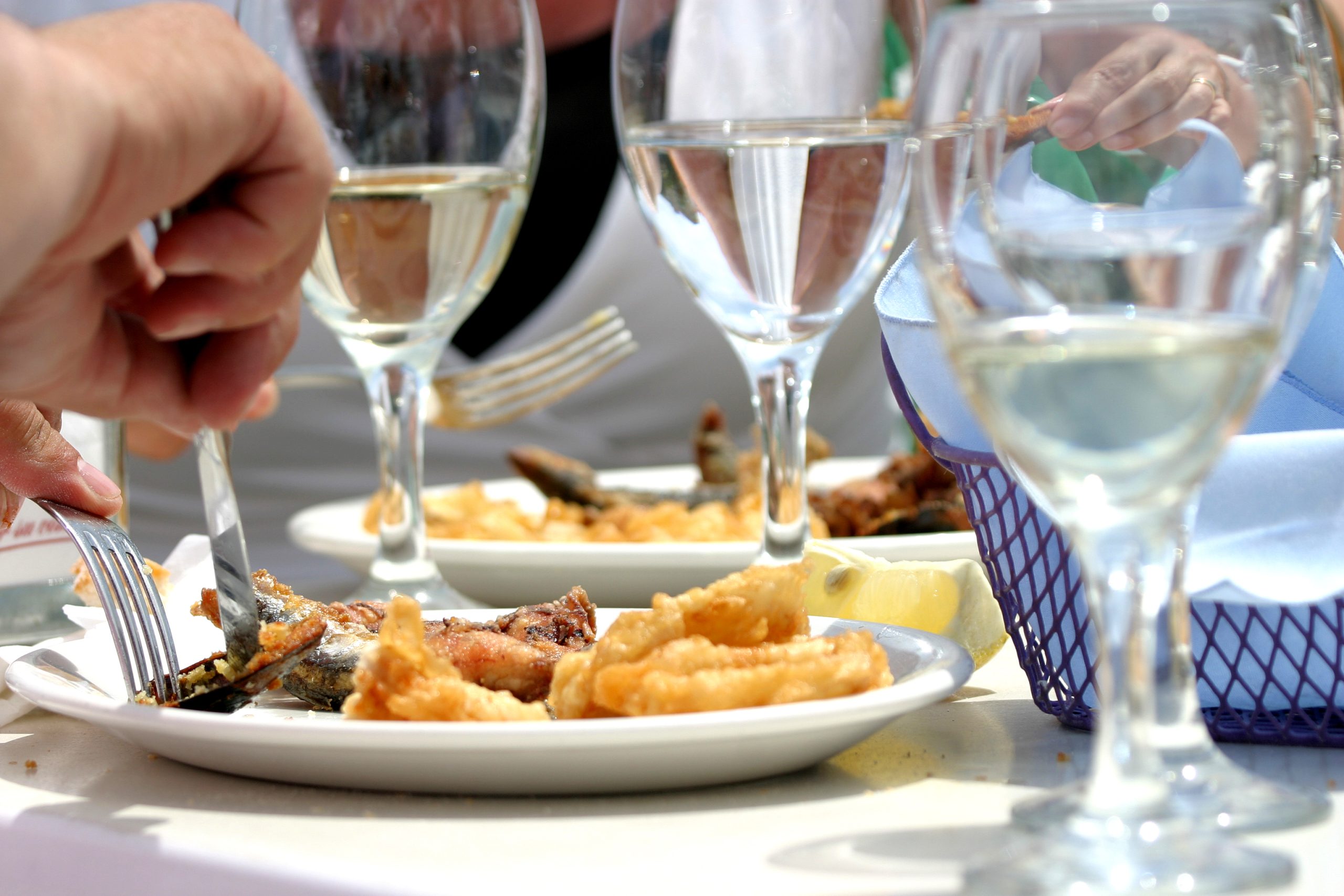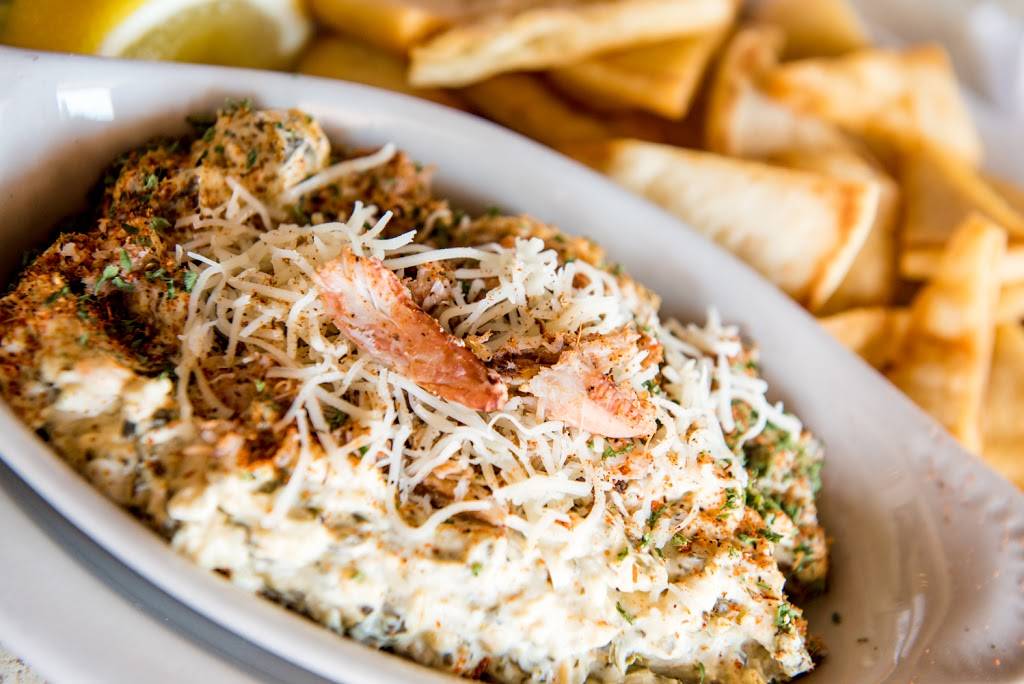Posted by sharkeysadmin
Beat the Heat: Where to Cool Off with a Cocktail on the Myrtle Beach Boardwalk
Summer in Myrtle Beach is electric—sunshine, surf, and endless energy along the coast. The Myrtle Beach Boardwalk buzzes with excitement all season long, from the moment the morning sun rises over the Atlantic to the final sparkle of evening lights. But when the heat kicks in and the sun starts to sizzle, you’ll want to find a spot that offers two things: refreshing drinks and an ocean breeze. That’s where Sharkey’s Oceanfront Restaurant comes in.
Whether you’re strolling the boardwalk, seeking a break from the beach, or meeting up with friends after a long, sun-soaked day, Sharkey’s is the go-to destination to cool off and chill out with a cocktail in hand.
Myrtle Beach Boardwalk: A Summer Must-See
Stretching 1.2 miles along the stunning Atlantic coastline, the Myrtle Beach Boardwalk and Promenade is one of the area’s most iconic summer attractions. It offers everything from live music and family-friendly events to carnival rides, unique shopping, and nonstop people-watching.
But for all its action, one thing’s for sure: the South Carolina sun doesn’t hold back. And as temperatures climb, every smart boardwalk-goer knows to plan their escape from the heat. That’s where a well-timed frozen drink becomes not just a treat—but a necessity.
Sharkey’s: Your Breezy Oceanfront Escape
Located directly on the Myrtle Beach Boardwalk, Sharkey’s Oceanfront Restaurant offers more than just a meal—it delivers a refreshing experience. With an open-air layout, shaded seating, and panoramic views of the ocean, Sharkey’s provides the perfect respite from the sun without stepping too far from the boardwalk action.
Feel that coastal breeze? Hear the waves just beyond the deck? That’s your cue to grab a cold drink and stay awhile.
Sip & Chill: Sharkey’s Frozen Cocktail Favorites
When it comes to beating the heat, Sharkey’s serves up a variety of frozen cocktails that are as Instagram-worthy as they are refreshing. Some customer favorites include:
- Frozen Piña Coladas – Creamy, tropical, and blended to perfection. It’s like vacation in a glass.
- Strawberry Daiquiris – Sweet, icy, and made with fresh fruit flavor—ideal for sipping under the sun.
- Frozen Margaritas – Classic lime or go bold with mango or strawberry twists.
- Sharkey’s Signature Blends – Ask the bartender for the house specials. They’re known for crafting vibrant frozen drinks with fun names and big flavor.
For guests who prefer a non-alcoholic option, Sharkey’s also offers frozen mocktails and smoothies, perfect for kids or anyone looking to stay cool without the buzz.
Perfect Pairings from the Kitchen
Sure, a frozen cocktail can steal the show—but at Sharkey’s, the food is just as cool. The menu is loaded with seafood favorites and beach bar classics that pair beautifully with a cold drink. A few pairing ideas:
- Fish Tacos + Frozen Margarita – A classic duo with tangy, tropical vibes.
- Peel-and-Eat Shrimp + Piña Colada – Sweet, spicy, and perfectly beachy.
- Wings or Sliders + a Cold Daiquiri – For those who like their bite with a little heat and a smooth, chilled finish.
Whether you’re stopping in for a full lunch or just craving a salty snack, Sharkey’s has something to balance every sip.
Ocean Breezes Included
One of Sharkey’s best features? The natural cooling system. Positioned right on the water, the steady ocean breeze and shaded outdoor seating provide a built-in chill zone. It’s not just about escaping the heat—it’s about embracing the atmosphere.
Take a seat at the edge of the deck, watch the waves roll in, and feel the temperature drop (both literally and figuratively) as you enjoy your drink with a view.
Great Vibes for Everyone
Sharkey’s is a welcoming place for:
- Groups of friends catching up over cocktails
- Couples looking for a romantic beachside break
- Families stopping in for a cool-down after a long day at the beach
- Solo travelers enjoying a little “me time” with a view
With a laid-back, come-as-you-are vibe, Sharkey’s is the kind of place that turns casual visits into memorable moments.
Ready to Sip, Chill, and Repeat?
The Myrtle Beach Boardwalk has a lot to offer—but when the sun gets high and the humidity kicks in, don’t just power through it. Make a smart move. Step into Sharkey’s, grab a frozen drink, and let the ocean breeze do the rest.
Whether you’re exploring the boardwalk for the first time or returning for another summer of fun, Sharkey’s is your ultimate cool-down destination. Stop by, sip something tropical, and soak in the ocean views—your chill spot awaits.
Stay cool this summer at Sharkey’s Oceanfront Restaurant—right on the Myrtle Beach Boardwalk!
Stop by for a frozen drink, fresh seafood, and unbeatable views of the Atlantic. Whether you’re strolling the boardwalk or just looking for a laid-back spot to chill, Sharkey’s is your go-to oceanfront escape.
📍 600 N Ocean Blvd, Myrtle Beach, SC
⏰ Open 7 Days a Week | 🍹 Frozen Cocktails Daily
👉 View Our Menu
When summer hits Myrtle Beach, locals and tourists alike flock to the coastline in search of sun, surf, and good times. With so many options available, it can be hard to decide where to spend your afternoons and evenings—but Sharkey’s Oceanfront Restaurant makes that decision easy. Located right on the Myrtle Beach Boardwalk, Sharkey’s offers unbeatable views, fresh coastal cuisine, vibrant drinks, and a laid-back atmosphere that captures everything we love about beach life.
Prime Oceanfront Location
Sharkey’s isn’t just near the beach—it’s right on it. Nestled alongside the bustling Myrtle Beach Boardwalk, this oceanfront restaurant gives you panoramic views of the Atlantic from nearly every seat. Whether you’re enjoying lunch with family or sipping cocktails with friends as the sun dips below the horizon, you’re guaranteed a front-row seat to all the beauty Myrtle Beach has to offer.
And thanks to its location, Sharkey’s is just steps away from some of the area’s top attractions. Whether you’re spending the day riding the Myrtle Beach SkyWheel, browsing beach shops, or enjoying live music on the boardwalk, Sharkey’s is the perfect place to take a break, recharge, and soak in the view.
The Vibe: Laid-Back, Coastal, and Fun
Summer at Sharkey’s is all about relaxing, laughing, and enjoying life. The open-air patio lets you feel the ocean breeze, while the casual, colorful décor reminds you that this isn’t just a restaurant—it’s a destination. Whether you’re rolling in straight from the beach in flip-flops or dressed up for a fun night out, Sharkey’s is welcoming to everyone.
As the sun sets, the atmosphere really comes alive. With an upbeat playlist and a lively crowd, Sharkey’s becomes a buzzing hub of energy—especially on summer weekends when the boardwalk fills with tourists looking for a great time.
Crowd-Pleasing Menu with Coastal Flair
One of the reasons Sharkey’s stays packed all summer long? The food.
Our menu is packed with crowd favorites and fresh seafood dishes that capture the flavors of the coast. Here are just a few of the standout items that keep customers coming back:
- Sharkey’s Famous Grouper Tacos – Fresh grouper, cheddar and Monterey Jack cheese, pico de gallo, lettuce, and a chipotle drizzle wrapped in warm flour tortillas. It’s a must-try.
- Blackened Fish and Shrimp – Spicy, bold, and satisfying, this entrée comes with sautéed veggies and potatoes—perfect after a long beach day.
- Sharkey’s Crab Cake Dinner – Two 4oz. crab cakes topped with remoulade sauce and served with sides that are just as good as the main event.
- Firecracker Shrimp – Lightly breaded and tossed in a creamy, spicy sauce, this appetizer sets the tone for a fun, flavorful meal.
And for families, the kid’s menu is full of easy-to-love options like chicken tenders, popcorn shrimp, grilled cheese, and more.
Cocktails That Scream Vacation
What’s summer without a great drink in your hand? Sharkey’s cocktail menu is as vibrant and fun as the beach itself. Frozen daiquiris, tropical margaritas, and Sharkey’s signature drinks like the Shark Attack and Mermaid Water are perfect for sipping in the sun.
- Ocean Potion – A magical mix of vanilla vodka, pineapple juice, and grenadine.
- Bahama Mama – Rum, orange juice, pineapple juice, and grenadine—it tastes like summer in a glass.
- Blue Motorcycle – A powerful blend of spirits that’s as bold as it is blue.
Whether you’re a fan of sweet and fruity or strong and classic, the drink list has something for everyone.
Perfect for Groups and Events
While Sharkey’s shines as a go-to for casual lunches and sunset dinners, it also doubles as an event-ready venue. During the off-season, the restaurant welcomes private parties, corporate gatherings, and special celebrations. The open-air space, oceanfront views, and custom catering options make it an ideal choice for anyone looking to host a memorable event at the beach.
So whether you’re planning a reunion, birthday, or holiday party, Sharkey’s gives you the beachside setting without the stress.
Easy Access and a Welcoming Staff
Sharkey’s doesn’t just offer a great location and stellar food—it’s also easy to find and welcoming to everyone. Our team is here to make your summer experience smooth and memorable, from greeting you with a smile to recommending the perfect cocktail for your taste.
We’re open seven days a week starting at 12 PM, so you can count on us for lunch, dinner, or drinks every day of the summer.
Make Sharkey’s Part of Your Myrtle Beach Summer
If you’re heading to Myrtle Beach this season, don’t miss your chance to visit one of the most talked-about oceanfront spots in town. Whether you’re dropping by for a quick drink, enjoying a full dinner, or planning a party, Sharkey’s Oceanfront Restaurant offers the perfect blend of beach vibes, great food, and unforgettable views.
So come grab a table, sip something cold, and savor the season at Sharkey’s—where every visit feels like a vacation.
Myrtle Beach, a hub of sun, surf, and sand during the summer months, transforms into a serene getaway in the off-season. This article explores the unique charms and diverse experiences available throughout the year, especially during the quieter months.
Weather Patterns and What to Expect
In Myrtle Beach, the bustling summer heat gives way to mild and pleasantly cool winters. While the peak season boasts hot, sunny days ideal for beach-going, the off-season offers comfortable temperatures perfect for exploring outdoor attractions without the discomfort of intense heat.
Off-Season Attractions
The off-season doesn’t mean a pause in fun; Myrtle Beach is home to numerous attractions that cater to visitors year-round. The Myrtle Beach Boardwalk, for instance, remains open, offering peaceful strolls with fewer crowds. Indoor attractions like the Hollywood Wax Museum or Ripley’s Aquarium provide perfect diversions on cooler days.
Events Exclusive to the Off-Season
Winter months are speckled with unique events that draw locals and tourists alike. The Nights of a Thousand Candles at Brookgreen Gardens showcases breathtaking light displays, while holiday markets and New Year’s celebrations add festive cheer to the cooler months.
Benefits of Visiting During the Off-Season
Traveling to Myrtle Beach during the off-season comes with numerous advantages. Hotel rates drop significantly, and popular spots are less crowded, allowing for a more relaxed experience. This season also offers a unique opportunity to engage with local culture more authentically, attending community events that are less tourist-focused.
Dining and Shopping
Many of Myrtle Beach’s restaurants and shops offer year-round delights with special off-season menus and sales. Local seafood remains abundant, and many establishments feature seasonal specialties that give a true taste of the region.
Outdoor Activities and Adventures
Even in cooler weather, Myrtle Beach’s natural landscapes beckon. The milder temperatures are ideal for golfing, a favorite pastime in the area with fewer wait times and lower fees. State parks like Myrtle Beach State Park offer quiet, scenic spots for hiking and wildlife observation.
Tips for Planning an Off-Season Visit
When planning a visit during the off-season, consider packing layers to accommodate fluctuating temperatures. Booking in advance can secure the best rates, and keeping an eye on local event calendars ensures you won’t miss out on unique seasonal activities.
Final Thoughts
Visiting Myrtle Beach during the off-season offers a different but equally fulfilling experience compared to the bustling summer months. With cooler weather, fewer crowds, and lower prices, the off-season might just be the perfect time to explore the quieter, more intimate side of this beloved coastal city. Whether you’re looking for relaxation or adventure, consider Myrtle Beach for your next off-season getaway.
Nestled on the iconic shores of Myrtle Beach, Sharkey’s Oceanfront Restaurant offers a dining escapade that transcends the ordinary, blending the mesmerizing Atlantic sunsets with unmatched culinary expertise. A visit to Sharkey’s isn’t just about the food; it’s about creating memorable experiences against a backdrop of stunning ocean views and soothing coastal breezes.
The Magic of Dining by the Ocean
The allure of Sharkey’s is magnified by its prime location along the vibrant Myrtle Beach Boardwalk. As the sun dips below the horizon, the sky paints itself in hues of orange and purple, setting a spectacular scene for an evening meal. Dining at Sharkey’s allows guests to immerse themselves in this picturesque setting, where each meal is complemented by the rhythmic sounds of the waves and the beauty of the coastline stretching into the sunset.
Signature Dishes and Drinks
Sharkey’s menu is a testament to culinary diversity, featuring a range of dishes that cater to all palates. The restaurant is renowned for its fish tacos—flaky, seasoned fish wrapped in soft tortillas and topped with fresh salsa. For those with a penchant for something a bit more exotic, the coconut shrimp offers a sweet and crunchy delight, perfectly paired with a tangy marmalade sauce.
The drink menu at Sharkey’s is equally impressive, featuring an array of colorful cocktails that are as visually appealing as they are delicious. The Shark Attack, a frozen concoction of dark spiced rum and tropical flavors, is a favorite among guests looking to cool down with a refreshing beverage. For a more classic taste, the handcrafted margaritas, available in various flavors, provide a crisp complement to any meal.
From Appetizers to Entrees
Start your meal with a selection from the extensive appetizer menu. The fried calamari, light and crispy, served with a side of marinara, sets the stage for a flavor-filled evening. For a richer start, the blackened scallops offer a smoky depth, enhanced by the restaurant’s signature seasoning.
As you transition to the main courses, the entree selections invite you to explore the depths of oceanic flavors. The grilled salmon, drizzled with wasabi mayo and teriyaki glaze, offers a perfect balance of sweet and tangy, while the Sharkey’s seafood platter—a medley of fried oysters, popcorn shrimp, and hand-breaded flounder—showcases the best of the sea.
Perfect Pairings
Choosing the right drink to complement your meal can elevate the dining experience. Pair the spicy notes of the blackened dishes with the smooth, sweet notes of a peach bellini or a frozen daiquiri to enhance the flavors. Non-alcoholic options, such as the house-made lemonade, offer a refreshing alternative without compromising the complexity of the meal’s flavors.
Why Choose Sharkey’s for Sunset Dining?
Dining at Sharkey’s is an experience that goes beyond mere consumption. It’s about savoring each moment, from the initial sight of the dish as it’s presented against the sunset backdrop to the last bite of a perfectly prepared meal. The restaurant’s commitment to quality and atmosphere makes it a must-visit destination for anyone looking to enjoy a meal that is as visually stunning as it is delicious.
How to Make the Most of Your Visit
To fully enjoy the Sharkey’s experience, consider making reservations around sunset time for the best views. The friendly staff can help recommend dishes and drinks that align with your preferences, ensuring that your meal is personalized and memorable. Don’t rush—plan to savor each course as the day transitions into night, making your dining experience at Sharkey’s a highlight of your visit to Myrtle Beach.
Sharkey’s Oceanfront Restaurant invites you to embark on a culinary journey where the sunset is your backdrop, and each dish tells a story of flavor and craftsmanship. Whether you’re a local or a visitor, make Sharkey’s your next dining destination and discover why it’s not just a meal, but an experience that captivates all the senses.
Posted by sharkeysadmin
Sunset Feasts: Why Sharkey’s Offers the Best Oceanfront Dining Experience in Myrtle Beach
Nestled along the tranquil shores of Myrtle Beach, Sharkey’s Oceanfront Restaurant stands as a beacon for those seeking a serene dining experience complemented by stunning sunset views. This unique setting offers an unparalleled opportunity to savor the quiet beauty of off-season dining, where each meal is framed by the picturesque backdrop of the setting sun.
Unmatched Location and Ambiance
At Sharkey’s, the allure of the ocean is undeniable. Diners can enjoy expansive views of the Atlantic, witnessing the sky’s transformation as the sun dips below the horizon. The off-season brings a special charm, with fewer crowds and a more intimate atmosphere, allowing guests to fully immerse themselves in the natural beauty and peaceful ambiance of the waterfront.
Exquisite Culinary Offerings
Sharkey’s prides itself on its commitment to freshness and quality, particularly with its seafood selections. The menu is a testament to local flavors, featuring dishes crafted from the catch of the day, ensuring that every bite is a celebration of oceanic bounty. Signature dishes, such as the grilled seabass or the classic shrimp cocktail, are perfected to enhance the sunset dining experience, making every meal memorable.
Ideal for Special Occasions
Whether it’s a romantic dinner for two or a significant celebration, Sharkey’s provides a perfect setting. The off-season’s calm environment allows for more personalized service, making it ideal for those special moments that call for a touch of elegance and privacy. The restaurant adapts to the unique needs of each event, ensuring that every guest’s experience is as exceptional as the view.
Enhancements to the Dining Experience
During the quieter months, Sharkey’s introduces special promotions and menu items that cater to the discerning palates of its guests. This time of year allows the restaurant to experiment with new dishes and offer seasonal specials that reflect the best of what the ocean has to offer. The enhanced service during the off-season ensures that every visit is tailored to the diner’s preferences, adding a personal touch to the exquisite dining experience.
Conclusion
Sharkey’s Oceanfront Restaurant invites you to discover why it’s celebrated as the best spot for sunset dining in Myrtle Beach. With its stunning views, exceptional seafood, and tailored dining experiences, Sharkey’s embodies the spirit of oceanfront dining. Experience the magic of the off-season at Sharkey’s, where every meal is a celebration of tranquility and culinary delight.
Understanding the seasonal availability of seafood enhances not only the culinary experience but also promotes environmentally conscious eating habits. This guide offers a detailed look at the best seafood to enjoy throughout the year and provides tips on how to select and prepare each type.
Winter (December – February)
Seafood Highlights: The cold months are perfect for enjoying shellfish like oysters and clams, which thrive in the chilly waters. Selection Tips: Choose oysters that are heavy for their size and clams that close when tapped, indicating freshness. Preparation Ideas: Serve oysters raw with a vinegar-based mignonette or steam clams with herbs for a cozy winter meal.
Spring (March – May)
Seafood Highlights: Spring sees the arrival of halibut and shrimp, offering a lighter option for the season. Selection Tips: Fresh halibut should have firm, white flesh, while shrimp should be firm and free of any ammonia scent. Preparation Ideas: Grill halibut with a light lemon-butter sauce or stir-fry shrimp with fresh spring vegetables.
Summer (June – August)
Seafood Highlights: Summer is prime time for crabs and lobsters, providing a festive centerpiece for dining. Selection Tips: Active crabs and lobsters are usually the freshest. Check for lively movement in the tank before purchasing. Preparation Ideas: Boil or steam crabs and lobsters and serve with butter and lemon wedges for a classic summer feast.
Fall (September – November)
Seafood Highlights: Scallops and mussels come into their prime in the fall, offering rich flavors. Selection Tips: Scallops should have a bright, moist appearance without any discoloration. Mussels should close tightly when tapped. Preparation Ideas: Sear scallops with butter and garlic or simmer mussels in a flavorful broth.
Year-Round Seafood Options
Some seafood like salmon and tilapia are great choices any time of the year. Look for bright, clear eyes and moist skin when selecting whole fish. Preparation Ideas: Versatile salmon can be baked, grilled, or poached, while tilapia is excellent pan-fried or baked with a crispy breadcrumb topping.
Conclusion
By choosing seafood that’s in season, you ensure the best quality and flavor while adhering to more natural consumption practices. Whether preparing a meal at home or dining out, being aware of seafood seasons can significantly enhance your culinary experiences.
Dining by the ocean is an experience like no other, combining the allure of vast, scenic views with the fresh tastes of culinary delights. Beachfront restaurants, such as those dotted along picturesque coastlines, offer a unique blend of sensory pleasures that elevate the dining experience beyond the ordinary. Here’s what makes these establishments truly special.
The Sensory Experience
The immediate appeal of beachfront dining is the sensory experience. The rhythmic sound of waves crashing against the shore provides a calming backdrop, while the fresh, salty air enhances the flavor of the food, particularly seafood. Visuals play a crucial part too; the sight of the sun setting over the ocean can turn a simple meal into a memorable event, making these locations perfect for romantic dinners and special occasions.
Culinary Inspirations
Proximity to the sea inspires menus that emphasize freshness and local flavors. Beachfront restaurants often have the advantage of serving seafood that has been caught just hours before it hits the plate. This not only supports local fishermen but also allows chefs to design menus that reflect the season’s best offerings, ensuring that guests enjoy ingredients at their peak.
Aesthetic and Design Elements
The architecture and interior design of beachfront restaurants often reflect their environment. Many feature open, airy spaces with large windows or outdoor seating to make the most of the coastal views. Nautical themes are common, with décor that complements the seaside setting, enhancing the overall dining atmosphere.
Challenges of Operating a Beachfront Restaurant
Operating a restaurant by the ocean is not without its challenges. Weather conditions can greatly affect business, with storms and high winds posing potential risks. Additionally, the salty air and humidity require that more attention be given to maintenance to preserve the integrity of the building and its interiors.
Marketing and Attraction
The romantic and picturesque setting of beachfront restaurants makes them particularly attractive for marketing to couples and event planners. They are coveted spots for weddings, anniversaries, and other celebrations. The unique location also makes these restaurants appealing for business events looking for a memorable setting.
Environmental Considerations
Sustainability is a significant focus for many beachfront restaurants. Many take strides to minimize their environmental impact by implementing practices such as sourcing sustainable seafood, reducing plastic use, and participating in beach clean-ups. This not only helps preserve the marine environment but also resonates with eco-conscious diners.
Conclusion
Beachfront restaurants offer more than just a place to eat; they provide a holistic experience that engages all senses. From the fresh seafood and the soothing sounds of the waves to the breathtaking views at sunset, these restaurants offer a gateway to experiencing the natural beauty of the coastline. Next time you find yourself by the sea, consider dining at a beachfront restaurant to fully appreciate the myriad delights of ocean-side dining.
Whether you’re planning a romantic evening, a family gathering, or a solo retreat, the unique charm and relaxed ambiance of dining by the waves are sure to make your experience unforgettable.
For a truly enchanting dining experience by the ocean, visit Sharkey’s Oceanfront Restaurant in Myrtle Beach. Enjoy our delicious seafood and stunning views for a memorable meal that combines the best of coastal dining with the charm of Myrtle Beach.
Seafood lovers know that the key to enjoying the freshest, most delicious seafood is understanding what’s in season. The southeastern United States, with its extensive coastline, offers a rich variety of seafood throughout the year. This guide will walk you through what types of seafood to look for each season if you’re dining or cooking in the Southeast.
Spring
Shrimp: Spring marks the beginning of the shrimp season in the Southeast. You’ll find fresh shrimp easier during this time, perfect for light, springtime dishes.
Crawfish: Often at its peak in late spring, especially in areas closer to the Gulf of Mexico, crawfish are a regional favorite, often enjoyed at festive crawfish boils.
Soft Shell Crab: As crabs molt their old exoskeletons and grow new ones, they pass through a “soft shell” phase. This delicacy is highly prized and typically available from late spring through early summer.
Summer
Blue Crab: Summer is the peak season for blue crab, a staple in the Southeast, particularly famous for dishes like crab cakes and crab boils.
Snapper: This is also a prime time for snapper, especially red snapper, known for its firm texture and nutty flavor, making it ideal for grilling.
Mahi-Mahi: Commonly found in warmer waters, mahi-mahi is available and abundant during the summer months, perfect for a variety of dishes from tacos to grilled fillets.
Fall
Oysters: Fall marks the start of oyster season in the Southeast. Oysters are best harvested when the water is cooler, and they are often said to be tastier in months containing ‘r’.
Grouper: This is also a good time for grouper, a fish appreciated for its mild, yet distinct flavor and suitable for a wide range of recipes.
Flounder: Available during the fall, flounder is another versatile fish, ideal for frying, steaming, or stuffing.
Winter
Stone Crab: Known especially for their claws, stone crabs are harvested from October to May, making winter a prime time to enjoy this treat.
Sea Bass: This is the season for sea bass, a rich, white fish that goes well in hearty winter dishes.
Pompano: This fish, which is highly esteemed for its taste, is typically in season during the colder months.
Year-Round
Catfish: Widely farmed and popular in southern cuisine, catfish are generally available throughout the year.
Tilapia: Another commonly farmed fish, tilapia is a versatile and sustainable option, available all year round.
Conclusion
Understanding seafood seasons not only helps in making better choices for freshness and flavor but also supports sustainable fishing practices. Whether you’re buying from your local market or ordering at a restaurant, knowing what seafood is in season can enhance your culinary experiences. Remember, seasonal availability can vary by specific regions and due to changing environmental conditions, so it’s always a good idea to check with local sources. Enjoy the best of what the Southeast has to offer and savor each bite from the sea!
Experience the Season’s Best at Sharkey’s Oceanfront Restaurant: Whenever you find yourself in Myrtle Beach, SC, make sure to visit Sharkey’s Oceanfront Restaurant. We pride ourselves on serving the freshest, in-season seafood. From spring’s tender shrimp to crab legs perfect for any season, each dish is crafted to highlight the season’s finest offerings. Join us by the beautiful Atlantic coast for a dining experience where quality, flavor, and stunning ocean views meet. Don’t miss out on the best seasonal seafood in Myrtle Beach — visit Sharkey’s today!
Pairing the right cocktail with your seafood dish can transform a good meal into an unforgettable dining experience. Whether you’re enjoying a casual dinner by the beach or hosting an elegant seafood feast at home, understanding how to match cocktails with various types of seafood will allow you to enhance the flavors of both. Here’s your ultimate guide to the best cocktail pairings for different types of seafood.
Crisp Whites and Light, Flaky Fish
Seafood Type: Light and Flaky Fish Cocktail: Classic Mojito
Begin with something light, such as grilled or poached flaky fish, known for its delicate, buttery texture. Pair this with a classic Mojito. The freshness, minty notes, and splash of lime in the Mojito complement the subtle flavors of the fish, enhancing its natural sweetness without overwhelming the palate. This pairing is perfect for those who appreciate the lighter side of seafood.
Bold Flavors for Firm, Meaty Fish
Seafood Type: Firm, Meaty Fish Cocktail: Spicy Margarita
For those who favor bold flavors, a dish featuring blackened or grilled meaty fish is an excellent choice. Accompany this with a Spicy Margarita. The cocktail’s crisp tequila base and spicy undertones cut through the richness of the fish, balancing the heat and highlighting the robust seasoning.
Tropical Pairings for Shrimp and Other Shellfish
Seafood Type: Shrimp and Other Shellfish Cocktail: Piña Colada
Nothing says tropical dining like shrimp or mixed shellfish dishes paired with a creamy Piña Colada. The sweet and rich profile of the cocktail, laden with coconut cream and pineapple juice, offers a delightful contrast to the savory and aromatic flavors of the shellfish, making each bite a luxurious indulgence.
Elegant Combinations for Crab and Lobster
Seafood Type: Crab and Lobster Cocktail: Champagne Cocktail
Opt for a touch of elegance with dishes featuring crab or lobster, accompanied by a sophisticated Champagne Cocktail. The bubbly texture and crispness of the champagne enhance the rich, tender flesh of the seafood, elevating the entire dining experience.
Citrusy Delights for Fried Seafood Favorites
Seafood Type: Fried Seafood Favorites Cocktail: Lemon Drop Martini
A plate of fried seafood, with its crispy texture and light flavor, pairs wonderfully with the sharp, sweet-and-sour profile of a Lemon Drop Martini. The cocktail’s strong citrus notes cut through the fried exterior, cleansing the palate and complementing the mild taste of the seafood.
Conclusion: Mixing and Matching for the Perfect Meal
Mastering the art of pairing cocktails with seafood is all about balancing flavors to enhance the dining experience. Whether you are dining out or creating these pairings at home, experimenting with different combinations can lead to delightful discoveries. Next time you plan a seafood meal, consider these pairing suggestions to elevate your dining experience, making it memorable with every sip and bite. Cheers to a delicious adventure in flavor!
Visit Sharkey’s Oceanfront Restaurant: Next time you’re in Myrtle Beach, enhance your dining experience by visiting Sharkey’s Oceanfront Restaurant. Enjoy our expertly crafted cocktails and exquisite seafood in a stunning beachfront setting. Whether you’re looking for a romantic evening or a family dinner, Sharkey’s offers the perfect blend of ambiance and flavor. Don’t just take our word for it—come and see for yourself why we’re a beloved spot for both locals and visitors alike!
Pairing the right drink with seafood can transform a good meal into an extraordinary culinary experience. Whether you’re enjoying a simple grilled fish or indulging in a decadent seafood platter, the perfect beverage can elevate your dish by enhancing its flavors and textures. This guide will walk you through the essentials of pairing seafood with wines, beers, and cocktails, ensuring that every bite is as delightful as the last.
The Basics of Seafood and Drink Pairing
Understanding the basic flavor profiles of seafood is crucial in selecting the right beverage. Generally, seafood can be categorized by its richness and texture, ranging from light and flaky fish to rich and creamy shellfish. The pairing principle is simple: aim to match the intensity of the food with the drink, ensuring one does not overpower the other.
Pairing Wine with Seafood
Light Fish: Delicate fish like tilapia, flounder, and sole pair wonderfully with light white wines. Pinot Grigio and Sauvignon Blanc are excellent choices as their crisp and fresh flavors complement the subtlety of the fish without overwhelming it.
Rich Fish: For oilier, richer fish such as salmon or tuna, opt for fuller-bodied whites like Chardonnay or Viognier. These wines balance the richness of the fish with their robust flavors and creamy textures.
Shellfish: When it comes to shellfish like oysters, clams, and mussels, nothing beats a glass of sparkling wine. Prosecco or Champagne not only adds a touch of elegance but the bubbles and crispness cut through the seafood’s richness, enhancing its natural flavors.
Beer and Seafood Combinations
Ale with Fried Seafood: The caramel notes of ales, such as amber or brown ale, complement the golden fried crust of fish and chips or battered shrimp, balancing the greasiness with their sweet undertones.
Lagers with Grilled Seafood: The clean, crisp taste of a light lager works wonderfully with grilled seafood. The subtle char and smokiness of the grill are enhanced by the refreshing finish of the lager.
Stouts with Rich Shellfish: The deep, roasted flavors of stouts or porter beers are a surprising but excellent match for luxurious seafood like lobster or crab, offering a robust contrast to the creamy textures.
Crafting Seafood Cocktails
Citrus Cocktails for Light Seafood: A zesty margarita or a lemon-based cocktail can add a bright pop to light fish dishes, echoing the traditional squeeze of a lemon wedge that often accompanies seafood.
Herb-Infused Cocktails for Herbal Dishes: For seafood seasoned with herbs, try a cocktail that mirrors these elements. A rosemary gin fizz or a basil smash can bring out the aromatic freshness of the herbs used in the dish.
Spicy Cocktails for Bold Flavors: For spiced or blackened seafood, a cocktail with a kick, such as a Bloody Mary or a spicy jalapeño margarita, can stand up to the intensity and enhance the overall flavor profile.
Non-Alcoholic Options
Not everyone drinks alcohol, but that doesn’t mean missing out on creative pairings. Sparkling water with a twist of citrus can cleanse the palate between bites, while mild herbal teas like chamomile or mint can subtly complement the flavors of delicate seafood without overwhelming them.
Themed Seafood Dinner Ideas
Why not throw a themed dinner party centered around these pairings? Consider a Mediterranean night featuring seafood paella paired with sangria, or a summer seafood feast with various grilled fish and a selection of light beers and white wines.
Tips for Experimenting at Home
The best way to discover your favorite pairings is through experimentation. Try different combinations to see what works best for your palate. Remember, the best pairing is one that you enjoy the most, regardless of traditional guidelines.
Conclusion
Mastering the art of pairing drinks with seafood will surely enhance your dining experience, whether you’re hosting a dinner party or enjoying a quiet meal by the sea. Next time you’re planning a seafood dish, consider these pairing suggestions to elevate your meal to the next level. And if you’re dining out, don’t hesitate to ask for pairing recommendations—they might lead you to discover your new favorite combination!
Experience the Perfect Pairing at Sharkey’s: After exploring the art of drink and seafood pairing, why not put your knowledge to the test at Sharkey’s? Located right on the Myrtle Beach Boardwalk, Sharkey’s offers a stunning array of seafood dishes perfectly complemented by our expertly curated selection of wines, beers, and cocktails. Whether you’re craving a light, citrusy cocktail with our grilled fish or a bold stout to go with our rich shellfish platter, Sharkey’s has the perfect pairing waiting for you. Visit us to savor the flavors and views that only Sharkey’s can offer. Book your table today and elevate your dining experience to a memorable oceanfront adventure.
Recent Posts
- Beat the Heat: Where to Cool Off with a Cocktail on the Myrtle Beach Boardwalk
- Why Sharkey’s Is the Hottest Oceanfront Spot in Myrtle Beach This Summer
- Myrtle Beach Through the Seasons: What to Expect Year-Round
- Savor the Sunset: Culinary Delights at Sharkey’s Oceanfront Experience
- Sunset Feasts: Why Sharkey’s Offers the Best Oceanfront Dining Experience in Myrtle Beach

